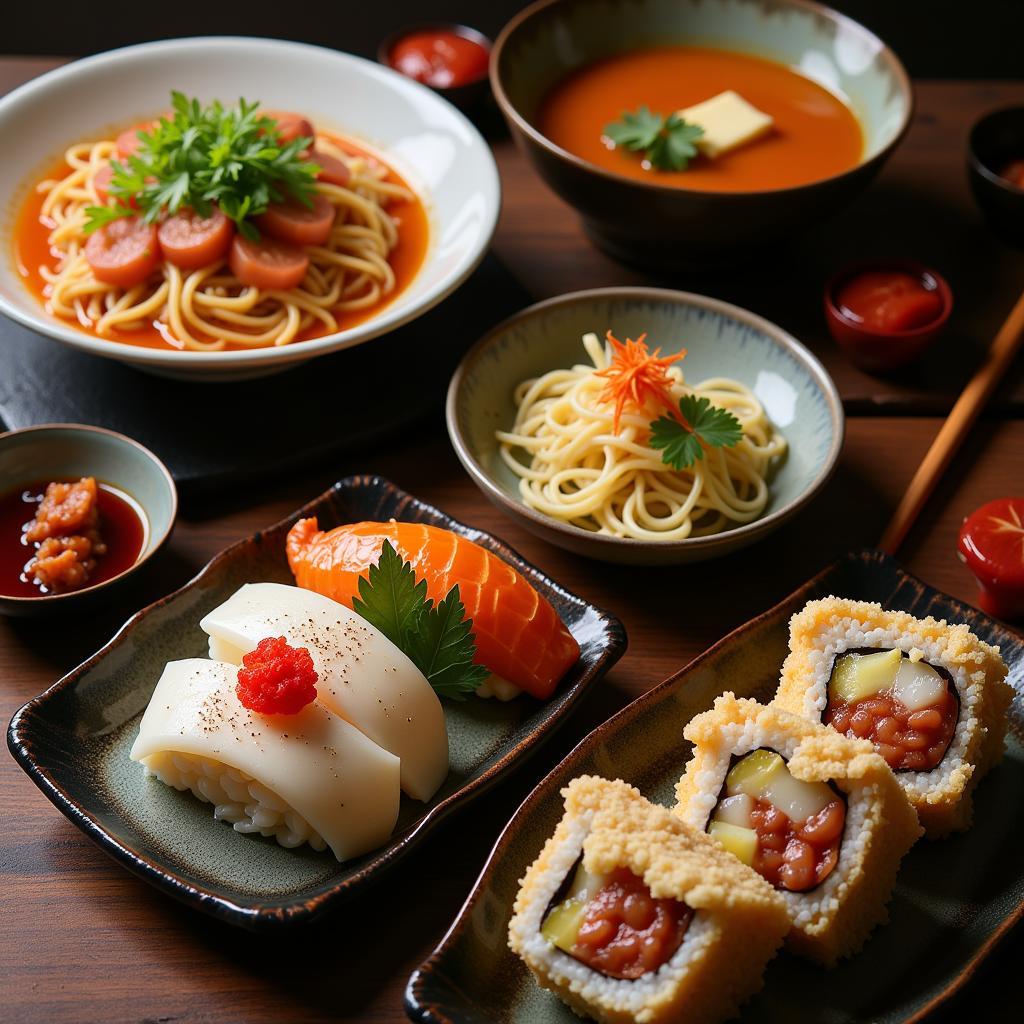The world of food is a vast and exciting place, and few cuisines capture the imagination quite like Japanese Food Vs Korean Food. Both offer an explosion of flavor, but their approaches to ingredients, cooking techniques, and dining experiences are distinctly different. Let’s dive into a side-by-side comparison of these two Asian culinary giants, exploring what sets them apart and why you might choose one over the other.
A Tale of Two Flavors: Umami Versus Spice
One of the most noticeable differences between Japanese and Korean food lies in their flavor profiles. Japanese cuisine is often characterized by its delicate balance and emphasis on umami, the savory fifth taste. Think of the rich, savory depth of a bowl of ramen or the subtle sweetness of perfectly seasoned sushi rice.
 Japanese Food Umami: Examples
Japanese Food Umami: Examples
Korean food, on the other hand, is renowned for its bold and spicy flavors. Gochujang, a fermented chili paste, is a staple ingredient, adding a fiery kick to everything from stews and stir-fries to kimchi, the iconic fermented cabbage dish.
 Korean Food Spicy Delights
Korean Food Spicy Delights
Beyond the Bite: Cultural Significance of Food
Food in both Japan and Korea is deeply intertwined with cultural traditions and customs. In Japan, the emphasis on seasonality and presentation elevates dining to an art form. Meals are meticulously plated, showcasing the natural beauty of ingredients. The Japanese tea ceremony, with its precise rituals and focus on harmony, exemplifies this cultural reverence for food.
In Korea, communal dining is paramount. Korean barbecue, where diners grill meat at their table, fosters a sense of togetherness. Banchan, an assortment of small side dishes, is another hallmark of Korean dining, encouraging sharing and variety.
Iconic Dishes: A Culinary Passport
No exploration of Japanese food vs Korean food would be complete without a look at their signature dishes:
Japanese Food:
- Sushi: Perhaps Japan’s most famous culinary export, sushi needs no introduction. Vinegared rice topped with fresh seafood, it’s a delicate dance of flavors and textures.
- Ramen: This soul-warming noodle soup, with seemingly endless regional variations, is a testament to Japan’s culinary diversity.
- Tempura: Lightly battered and deep-fried seafood and vegetables, tempura embodies the Japanese pursuit of culinary perfection.
Korean Food:
- Kimchi: This spicy, fermented cabbage is a cornerstone of Korean cuisine, appearing as a side dish or incorporated into countless other recipes.
- Bibimbap: A colorful and flavorful rice dish topped with meat, vegetables, a fried egg, and gochujang, bibimbap offers a satisfying and complete meal in a bowl.
- Korean BBQ: More than just a meal, Korean BBQ is a social experience, where diners grill marinated meats and enjoy them wrapped in lettuce with various accompaniments.
Japanese Food vs Korean Food: Which Will You Choose?
Ultimately, the choice between Japanese food vs Korean food is a matter of personal preference. Do you crave the subtle elegance of umami or the fiery thrill of spice? The artistic presentation of Japanese cuisine or the communal spirit of Korean dining? Whichever you choose, one thing is certain: you’re in for a delicious and unforgettable culinary adventure.
FAQs: Unraveling the Culinary Mystery
1. Is all Korean food spicy?
While Korean cuisine is known for its spice, not all dishes are fiery. There are plenty of milder options available, and you can always adjust the level of spice to your liking.
2. What is the difference between Japanese and Korean barbecue?
Both cuisines feature barbecue, but with distinct differences. Japanese barbecue often uses smaller, more delicate cuts of meat, while Korean barbecue typically involves larger portions and marinades.
3. Are there vegetarian options in Japanese and Korean food?
Absolutely! Both Japanese and Korean cuisine offer a variety of vegetarian dishes, from vegetable tempura and sushi rolls to japchae (glass noodles with vegetables) and bibimbap with tofu.
4. What are some good beverages to pair with Japanese and Korean food?
Green tea is a classic accompaniment to both Japanese and Korean meals. Other popular choices include sake (Japanese rice wine), soju (Korean distilled spirit), and Korean beer.
5. Where can I find authentic Japanese and Korean food?
Look for restaurants in areas with a strong Japanese or Korean community. Online reviews and recommendations from friends can also point you in the right direction.
Explore More Culinary Delights
For a deeper dive into the world of Japanese and Korean cuisine, check out these articles:
- Japanese vs Korean Food: A comprehensive guide to understanding the nuances of these two fascinating culinary traditions.
- Korean vs Japanese Food: Discover the key differences and similarities between Korean and Japanese cuisine.
Need Help Navigating the Culinary Landscape?
Contact our dedicated customer support team 24/7. Call us at 02437655121, email us at [email protected], or visit us at 3PGH+8R9, ĐT70A, thôn Trung, Bắc Từ Liêm, Hà Nội, Việt Nam. We’re here to guide your culinary journey!